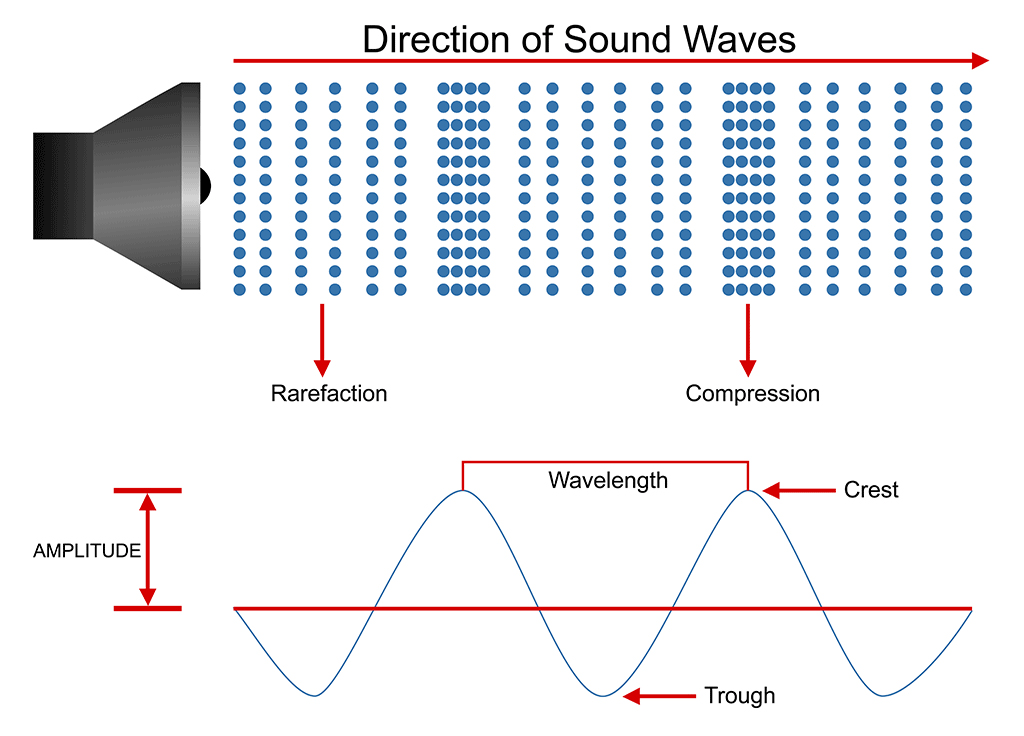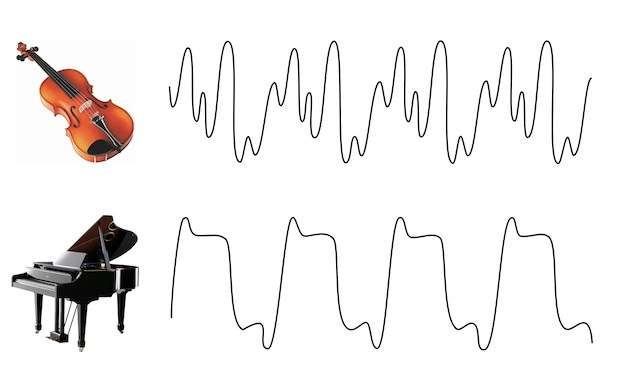
Sound and its properties
Contents
Sound is a physical objective phenomenon. Its source is any elastic body capable of producing mechanical vibrations. As a result, sound waves are formed that reach the human ear through the air. It perceives waves and converts them into nerve impulses that are transmitted to the brain and processed by its hemispheres. As a result, a person becomes aware of a particular sound.
There are three categories of sounds:
- Musical – have a certain height, volume, timbre and other characteristics; are considered the most organized, they are distinguished by a wealth of dynamic and timbre properties.
- Noise – sounds whose pitch is indefinite. These include sea noise, wind whistling, creaking, clicks and many others.
- Sounds without focused pitch .
To create compositions, only musical sounds are used, occasionally – noise.
sound waves
This is rarefaction and condensation of sound in an elastic, or sound-conducting, medium. When a mechanical vibration of the body has occurred, the wave diverges through a sound-conducting medium: air, water, gas, and various liquids. Propagation occurs at a different rate, which depends on the specific medium and its elasticity. In air, this indicator of a sound wave is 330-340 m / s, in water – 1450 m / s.
The sound wave is invisible, but audible to a person, because it affects his eardrums. It needs a medium to spread. Scientists have proven that in a vacuum, that is, a space without air, a sound wave can form, but not propagate.
Sound receivers
 This is the name of devices that perceive sound energy, measure the characteristics of a sound wave (pressure, intensity, speed, etc.) and convert it into another energy. To receive sound in various environments, the following are used:
This is the name of devices that perceive sound energy, measure the characteristics of a sound wave (pressure, intensity, speed, etc.) and convert it into another energy. To receive sound in various environments, the following are used:
- microphones – for airspace ;
- geophones – for the perception of the sounds of the earth’s crust;
- hydrophones – to receive sound in the water.
There are natural sound receivers – hearing aids of people and animals – and technical ones. When an elastic body oscillates, the resulting waves reach the hearing organs after some time. The eardrum vibrates at a frequency that matches that of the sound source. These tremors are transmitted to the auditory nerve, and it sends impulses to the brain for further processing. Thus, certain sound sensations appear in humans and animals.
Technical sound receivers convert an acoustic signal into an electrical one. Thanks to this, the sound is transmitted at different distances, it can be recorded, amplified, analyzed, etc.
Properties and characteristics of sound
Height
This is a characteristic of sound, depending on the frequency with which the physical body vibrates. Its unit of measurement is hertz ( Hz ): the number of periodic sound vibrations in 1 second. Depending on the frequency of vibrations, sounds are distinguished:
- low-frequency – with a small number of oscillations (not higher than 300 Hz );
- mid -frequency – sounds oscillating with a frequency of 300-3,000 Hz ;
- high-frequency – with a number of oscillations exceeding 3,000 Hz .

Duration
To determine this characteristic of sound, it is necessary to measure the duration of vibrations of the body that emits the sound. The musical sound lasts from 0.015-0.02 s. up to several minutes. The longest sound is produced by the organ pedal.
Volume
In another way, this characteristic is called the sound power, which is determined by the amplitude of the oscillations: the larger it is, the louder the sound and vice versa. Loudness is measured in decibels (dB). In musical theory, gradation is used to indicate the strength of sound with which it is necessary to reproduce a composition:
- forte;
- piano;
- mezzo forte;
- mezzo piano;
- fortissimo;
- pianissimo;
- forte-fortissimo;
- piano-pianissimo, etc.

Another characteristic is closely related to the loudness of sound in musical practice – dynamics. Thanks to dynamic shades, you can give the composition a certain shape.
They are achieved by the skill of the performer, the acoustic properties of the room and musical instruments.
Other characteristics
Amplitude
This is a characteristic that affects the volume of the sound. The amplitude is half the difference between the maximum and minimum density values.
Spectral composition
The spectrum is the distribution of a sound wave in frequency m into harmonic vibrations. The human ear perceives sound depending on the frequencies that make up the sound wave. They determine the pitch: high frequencies give high tones and vice versa. Musical sound has several tones:
- Fundamental – a tone that corresponds to the minimum frequency from the total frequency set for a particular sound.
- An overtone is a tone that corresponds to all other frequencies . There are harmonic overtones with frequencies that are multiples of the fundamental frequency.
Musical sounds that have the same basic tone are distinguished by their timbre . It is determined by the amplitudes and frequencies of the overtones, as well as by the increase in amplitude at the beginning and end of the sound.
Intensity
This is the name given to the energy that is transferred by a sound wave over a period of time through any surface. Another characteristic directly depends on the intensity – loudness. It is determined by the amplitude of oscillation in a sound wave. Regarding the perception by the human organs of hearing, the threshold of hearing is distinguished – the minimum intensity available for human perception. The limit beyond which the ear cannot perceive the intensity of a sound wave without pain is called the pain threshold.
It also depends on the audio frequency.
Timbre
Otherwise it is called sound coloring. The timbre is influenced by several factors: the device of the sound source, material, size and shape. The timbre changes due to various musical effects. In musical practice, this property affects the expressiveness of the work. The timbre gives the melody a characteristic sound.

About inaudible sounds
Regarding perception by the human ear, ultrasounds (with a frequency above 20,000 Hz ) and infrasounds (below 16 kHz) are distinguished. They are called inaudible, because the organs of hearing of people do not perceive them. Ultrasounds and infrasounds are audible to some animals; they are recorded by instruments.
A feature of an infrasonic wave is the ability to pass through a different medium, since the atmosphere, water or the earth’s crust absorb it poorly. Therefore, it spreads over long distances. The sources of waves in nature are earthquakes, strong winds, volcanic eruptions. Thanks to special devices that capture such waves, it is possible to predict the appearance of a tsunami and determine the epicenter of an earthquake. There are also man-made sources of infrasound: turbines, engines, underground and ground explosions, gun shots.
Ultrasonic waves have a unique property: they form directed beams like light. They are well conducted by liquids and solids, poorly by gases. The higher the frequency of ultrasound , the more intense it propagates. In nature, it appears during thunder peals, in the noise of a waterfall, rain, wind.
Some animals reproduce it on their own – bats, whales, dolphins and rodents.
Sounds in human life
The human ear is very sensitive due to the elasticity of the eardrum. The peak of people’s auditory perception falls on young years, when this characteristic of the auditory organ has not yet been lost and a person hears sounds with a frequency of 20 kHz. At an older age, people, regardless of gender, perceive sound waves worse: they hear only a frequency of no more than 12-14 kHz.
Interesting Facts
- If the upper threshold of frequencies perceived by the human ear is 20,000 Hz , then the lower one is 16 Hz . Infrasounds, in which the frequency is less than 16 Hz , as well as ultrasounds (above 20,000 Hz ), the human hearing organs do not perceive.
- WHO has established that a person can safely listen to any sound at a volume not exceeding 85 dB for 8 hours.
- For the perception of sound by the human ear, it is necessary that it lasts at least 0.015 seconds.
- Ultrasound cannot be heard, but it can be felt. If you put your hand in a liquid that conducts ultrasound, then there will be a sharp pain. In addition, ultrasound is able to destroy metal, purify the air, and destroy living cells.
Instead of output
Sound is the basis of any piece of music. The properties of sound, its characteristics make it possible to create various compositions. Depending on the pitch, duration, volume, amplitude or timbre , there are various sounds. To create works, mainly musical sounds are used, for which the pitch is determined.





